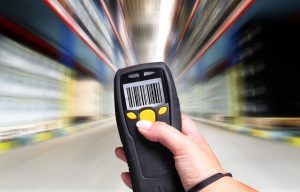Barcode scanners are extremely simple devices that can read and output printed barcodes to a computer. Like a flatbed scanner, it consists of a light source, a lens and a light sensor translating optical impulses into electrical ones. Additionally, nearly all barcode readers contain decoder circuitry analyzing the bar code’s image data provided by the sensor and sending the barcode’s content to the scanner’s output port.
There are four types of barcode scanners available on the market today. Each uses a slightly different technology for decoding and reading the barcode.
There are CCD readers, pen type readers (i.e., barcode wands), laser scanners and camera-based readers.
CCD Readers
CCD (Charge Coupled Device) readers use an array of hundreds of tiny light sensors lined up in a row in the head of the reader. Each sensor can be thought of as a single photo diode that measures the intensity of the light immediately in front of it. Each individual light sensor in the CCD reader is extremely small and because there are hundreds of sensors lined up in a row, a voltage pattern identical to the pattern in a barcode is generated in the reader by sequentially measuring the voltages across each sensor in the row. The important difference between a CCD reader and a pen or laser scanner is that the CCD reader is measuring emitted ambient light from the barcode whereas pen or laser scanners are measuring reflected light of a specific frequency originating from the scanner itself.
Pen Type Readers
Pen type readers consist of a light source and a photo diode that are placed next to each other in the tip of a pen or wand. To read a barcode, you drag the tip of the pen across all the bars in a steady even motion. The photo diode measures the intensity of the light reflected back from the light source and generates a waveform that is used to measure the widths of the bars and spaces in the barcode. Dark bars in the barcode absorb light and white spaces reflect light so that the voltage waveform generated by the photo diode is an exact duplicate of the bar and space pattern in the barcode. This waveform is decoded by the scanner in a manner similar to the way Morse code dots and dashes are decoded.
Laser Scanners
Laser scanners work the same way as pen type readers except that they use a laser beam as the light source and typically employ either a reciprocating mirror or a rotating prism to scan the laser beam back and forth across the barcode. Just the same as with the pen type reader, a photo diode is used to measure the intensity of the light reflected back from the barcode. In both pen readers and laser scanners, the light emitted by the reader is tuned to a specific frequency and the photo diode is designed to detect only this same frequency light.
Both pen type readers and laser scanners can be manufactured with different resolutions to enable them to read different sized barcodes. The resolution of the scanner is measured by the size of the dot of light that is emitted by the reader.
Camera Based Readers
The fourth and newest type of barcode reader currently available are camera-based readers that use a small video camera to capture an image of a barcode. The reader then uses sophisticated digital image processing techniques to decode the barcode. Video cameras use the same CCD technology as in a CCD barcode reader except that instead of having a single row of sensors, a video camera has hundreds of rows of sensors arranged in a two-dimensional array so that they can generate an image.
The factors that make a barcode readable are an adequate print contrast between the light and dark bars and having all bar and space dimensions within the tolerances for the symbology. It is also helpful to have sharp bar edges, few or no spots or voids, a smooth surface and clear margins or “quiet zones” at either end of the printed symbol.
Each design of barcode scanners will require a different type of precision lens. At Universe Optics, our dedicated team of engineers, along with our manufacturing facility, will craft the lens you require for your particular scanner.
Barcode scanning technology is moving into many different arenas. It is found everywhere from the convenient store to the manufacturing line. The information gathered by the barcode scanner is then transmitted to a computer, allowing for instant output of information that is accurate, and can help to streamline any operation.